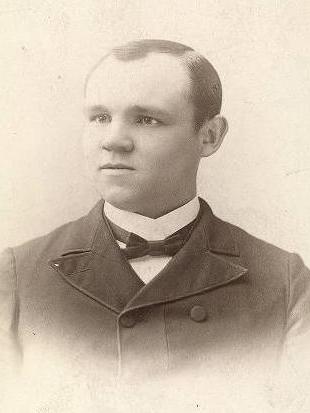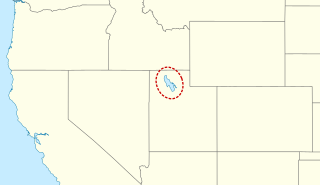
The Great Salt Lake is the largest saltwater lake in the Western Hemisphere and the eighth-largest terminal lake in the world. It lies in the northern part of the U.S. state of Utah and has a substantial impact upon the local climate, particularly through lake-effect snow. It is a remnant of Lake Bonneville, a prehistoric body of water that covered much of western Utah.

The State of Deseret was a proposed state of the United States, promoted by leaders of the Church of Jesus Christ of Latter-day Saints who had founded settlements in what is today the state of Utah. A provisional state government operated for nearly two years in 1849–50, but was never recognized by the United States government. The name Deseret derives from the word for "honeybee" in the Book of Mormon.

The "Great Moon Hoax", also known as the "Great Moon Hoax of 1835" was a series of six articles published in The Sun, beginning on August 25, 1835, about the supposed discovery of life and civilization on the Moon. The discoveries were falsely attributed to Sir John Herschel and his fictitious companion Andrew Grant.

The Salt Lake Tribune is a newspaper published in the city of Salt Lake City, Utah. The Tribune is owned by The Salt Lake Tribune, Inc., a non-profit corporation. The newspaper's motto is "Utah's Independent Voice Since 1871."

The Deseret News is a multi-platform newspaper based in Salt Lake City, published by Deseret News Publishing Company, a subsidiary of Deseret Management Corporation, which is owned by the Church of Jesus Christ of Latter-day Saints. Founded in 1850, it was the first newspaper to be published in Utah. The publication's name is from the geographic area of Deseret identified by Utah's pioneer settlers, and much of the publication's reporting is rooted in that region.

James Edward Talmage was an English chemist, geologist, and religious leader who served as a member of the Quorum of the Twelve Apostles of the Church of Jesus Christ of Latter-day Saints from 1911 until his death.

The Lucin Cutoff is a 102-mile (164 km) railroad line in Utah, United States that runs from Ogden to its namesake in Lucin. The most prominent feature of the cutoff was a twelve-mile-long (19 km) railroad trestle crossing the Great Salt Lake, which was in use from 1904 until the late 1950s, when it was replaced by an earthen causeway.
The Bear Lake Monster is a lake monster urban legend which appears in folklore near Bear Lake, on the Utah–Idaho border.

The North Shore Monster, sometimes referred to as "Old Briney," purportedly inhabits the Great Salt Lake in Utah. Descriptions of the monster vary, but it is most commonly described as having a crocodile-like body and the head of a horse.

Roy Lee Jefferson is an American former professional football player who was a wide receiver in the National Football League (NFL) for 12 seasons with the Pittsburgh Steelers, Baltimore Colts, and Washington Redskins. He played college football for the Utah Utes. During 162 regular season games in the NFL, he had 451 receptions for 7,539 yards and 52 touchdowns.

George Reynolds was a general authority of the Church of Jesus Christ of Latter-day Saints, a longtime secretary to the church's First Presidency, and a party to the 1878 United States Supreme Court case Reynolds v. United States, the first freedom of religion case to issue from that court.
Janne Mattson Sjödahl was a Swedish convert to the Church of Jesus Christ of Latter-day Saints and was the author of influential commentaries on LDS Church scriptures. Sjödahl was among the first commentators to advance a "limited geography model" for the theorized geography of the Book of Mormon.

Salt Lake High School East or simply East High School is a public high school in the Salt Lake City School District in Salt Lake City, Utah, United States. It serves grades nine through twelve in general and special education. East High School was founded in 1913 and currently has an enrolled student body of around 1,900. It is located at 840 South 1300 East in the East Bench neighborhood. The original building was completed in 1913, and the current structure was built in 1997.

The Eagle Gate is a historical monument which forms an arch across State Street in the downtown area of Salt Lake City, Utah. The monument pays homage to Brigham Young's 1859 Eagle Gate, which served as an entrance to his property and the City Creek Canyon road. After the road was publicly opened and the gates removed, the arch, with its perched eagle and beehive sculpture, remained over the street. Since then, the structure has been rebuilt twice; once in the 1890s and again in the 1960s.
The 1973 Utah Utes football team was an American football team that represented the University of Utah as a member of the Western Athletic Conference (WAC) during the 1973 NCAA Division I football season. In their sixth and final season under head coach Bill Meek, the Utes compiled an overall record of 7–5 with a mark of 4–2 against conference opponents, placing third in the WAC. Home games were played on campus at Robert Rice Stadium in Salt Lake City.
The 1963 Utah State Aggies football team was an American football team that represented Utah State University as an independent during the 1963 NCAA University Division football season. In their first season under head coach Tony Knap, the Aggies compiled an 8–2 record and outscored all opponents by a total of 318 to 99.
The 1971 Utah State Aggies football team was an American football team that represented Utah State University as an independent during the 1971 NCAA University Division football season. In their fifth season under head coach Chuck Mills, the Aggies compiled an 8–3 record and outscored all opponents 243 to 183.

The 1904 Utah gubernatorial election was held on November 8, 1904. Republican nominee John Christopher Cutler defeated Democratic nominee James Moyle with 49.97% of the vote.
Jean Baptiste was a grave robber in 19th-century Utah whose disappearance has been the subject of local legend. His activities were uncovered in 1862 after it was discovered that the body of Moroni Clawson, an outlaw, had been stripped of its burial clothes. Baptiste was banished to Fremont Island in the Great Salt Lake, and his fate after exile remains unknown.












